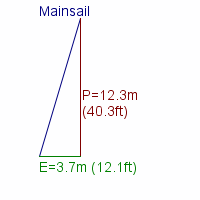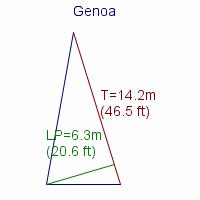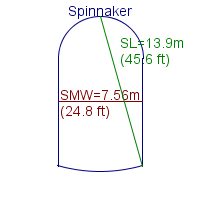Review of Maestro 35
Basic specs.

If you have a photo you would like to share: Upload Image
Looking for a new boat? Find a Maestro 35 or similar boat for sale
The hull is made of fibreglass. Generally, a hull made of fibreglass requires only a minimum of maintenance during the sailing season.
The hull is a double hull which improves the indoor climate. Especially when the water is colder than the air in the cabin, then the double hull insulates against cold water and reduce the condense water in the cabin.
The boat is equipped with 6 berths and a galley.
The Maestro 35 is equipped with a masthead rig. The advantage of a masthead rig is its simplicity and the fact that a given sail area - compared with a fractional rig - can be carried lower and thus with less heeling moment.
Fin keel
The Maestro 35 is equipped with a fin keel. The fin keel is the most common keel and provides splendid manoeuvrability. The downside is that it has less directional stability than a long keel.
The boat can only enter major marinas as the draft is about 2.10 - 2.20 meter (6.89 - 7.19 ft) dependent on the load. See immersion rate below.
Maestro 35 may be equipped with an inboard Volvo Penta diesel engine
Sailing characteristics
This section covers widely used rules of thumb to describe the sailing characteristics. Please note that even though the calculations are correct, the interpretation of the results might not be valid for extreme boats.
What is Capsize Screening Formula (CSF)?
The capsize screening value for Maestro 35 is 1.96, indicating that this boat could - if evaluated by this formula alone - be accepted to participate in ocean races.
The immersion rate is defined as the weight required to sink the boat a certain level.
The immersion rate for Maestro 35 is about 252 kg/cm, alternatively 1411 lbs/inch.
Meaning: if you load 252 kg cargo on the boat then it will sink 1 cm.
Alternatively, if you load 1411 lbs cargo on the boat it will sink 1 inch.
Sailing statistics
This section is statistical comparison with similar boats of the same category. The basis of the following statistical computations is our unique database with more than 26,000 different boat types and 350,000 data points.
What is L/B (Length Beam Ratio)?
The l/b ratio for Maestro 35 is 3.07.
The ballast ratio for Maestro 35 is 44%.
What is SA/D (Sail Area Displacement ratio)?
The SA/D for Maestro 35 with ISO 8666 reference sail is 16.1, with a 135% genua the SA/D is 19.3.
What is Relative Speed Performance?
The Relative Speed Performance for Maestro 35 is 46
Maintenance
Dimensions of sail for masthead rig.



Are your sails worn out? You might find your next sail here: Sails for Sale
If you need to renew parts of your running rig and is not quite sure of the dimensions, you may find the estimates computed below useful.
| Usage | Length | Diameter | ||
| Mainsail halyard | 32.0 m | (105.2 feet) | 12 mm | (1/2 inch) |
| Jib/genoa halyard | 32.0 m | (105.2 feet) | 12 mm | (1/2 inch) |
| Spinnaker halyard | 32.0 m | (105.2 feet) | 12 mm | (1/2 inch) |
| Jib sheet | 10.8 m | (35.3 feet) | 14 mm | (0.55 inch) |
| Genoa sheet | 10.8 m | (35.3 feet) | 14 mm | (0.55 inch) |
| Mainsheet | 26.9 m | (88.2 feet) | 14 mm | (0.55 inch) |
| Spinnaker sheet | 23.7 m | (77.6 feet) | 14 mm | (0.55 inch) |
| Cunningham | 3.7 m | (12.1 feet) | 12 mm | (1/2 inch) |
| Kickingstrap | 7.4 m | (24.3 feet) | 12 mm | (1/2 inch) |
| Clew-outhaul | 7.4 m | (24.3 feet) | 12 mm | (1/2 inch) |
This section is reserved boat owner's modifications, improvements, etc. Here you might find (or contribute with) inspiration for your boat.
Do you have changes/improvements you would like to share? Upload a photo and describe what you have done.
We are always looking for new photos. If you can contribute with photos for Maestro 35 it would be a great help.
If you have any comments to the review, improvement suggestions, or the like, feel free to contact us. Criticism helps us to improve.
